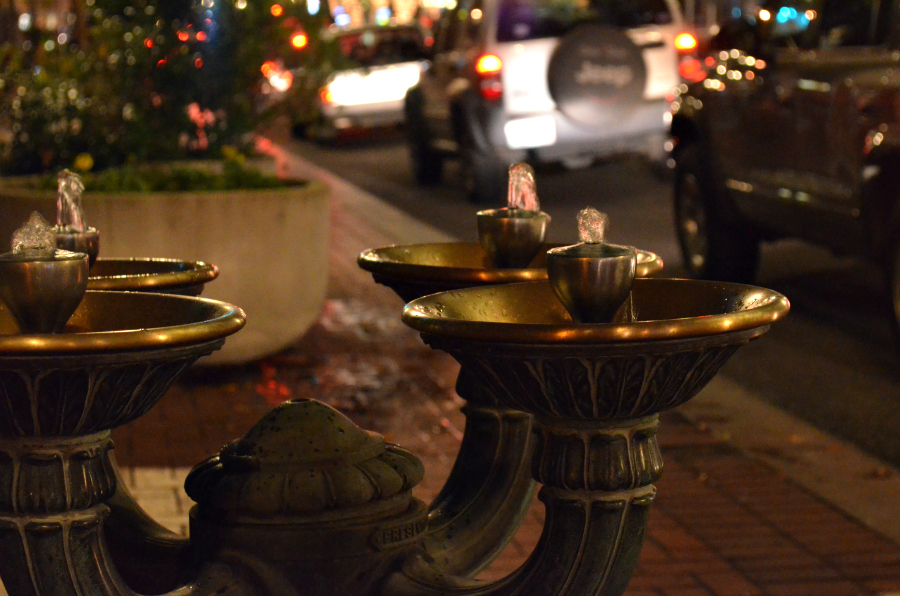
After work on December 5, no rain fell, so I took advantage of my walk from one homeward bound bus to the other. I stopped in at the Portland Building and took the photos in yesterday's post. Plus, I took this photo of a Benson Bubbler outside the Portland Building, near the southwest corner of SW 5th Avenue and SW Main Street. And, yes, I've had a drink from various Benson Bubblers around the city, without consequence other than quenching my thirst.
I'm especially proud of how this photo turned out--the soft light on the edges of the four bowls, the spigots, and the water; the traffic on SW 5th Avenue; the brick sidewalk. Note the wet look on the sidewalk, near that concrete planter. That's what happens when gusts of wind come in contact with bubbling water. Read on to discover the decision the city makes sometimes, all because of that contact.
About Benson Bubblers from the City of Portland's Web site:
Benson Bubblers are Portland's iconic drinking fountains. The city currently boasts 52 of the fountains and 74 one-bowl variations. Though the single-bowl variations look like Benson Bubblers, they are not. In fact, in the 1970's, the Benson family asked that the installation of the four-bowl fountains be limited to certain downtown boundaries so as not to diminish the uniqueness of them.
And while most Benson Bubblers are, indeed, downtown, there are a couple of notable exceptions.
- In 1965, the City of Portland presented a bubbler to Yosaku Harada, mayor of Portland's sister city, Sapporo, Japan.
- Sam Hill, a friend to Simon Benson, asked to have a bubbler installed at his Maryhill Museum of Art.
Bubbler Facts
Drinking water is fresh and NOT recycled, fountains are cleaned routinely.
- The Bubblers flow freely from 6:00 a.m. to 11:00 p.m., daily.
- The fountains run 365 days per year unless a cold snap or excessively windy weather forces the Water Bureau to temporarily shut them down.
- The fountains serve up Bull Run drinking water!
Benson Bubbler Legacy
In 1912, Simon Benson, a local businessman and philanthropist, donated $10,000 to the City of Portland to purchase and install 20 bronze drinking fountains, now known as Benson Bubblers.
Local folklore tells us that Simon Benson donated the 20 bronze drinking fountains as an effort to keep loggers out of the saloons at lunchtime. Others say that Benson was inspired after seeing a little girl crying at a 4th of July parade because she couldn't find a drink of water. Either way, the Benson Bubblers have become a historical and enduring legacy here in Portland.
Portland's first Benson Bubbler was installed at SW 5th & Washington. Another one of the original Bubblers was installed in front of Benson's home, where it remains today, to commemorate his generous gift to the city. The remaining 18 original bubblers were installed by 1917. Currently, the Water Bureau proudly maintains 52 of the four-bowl Benson Bubbler fountains throughout the city.
Construction & Design
A.E. Doyle designed the four-bowl Benson Bubbler. Doyle is the noted architect of the Multnomah County Library, Multnomah Falls Lodge and Portland's PGE Park.
Although most bubblers were made by local foundries, two bubblers were made by students at Benson High School. In 1975, the cost to make a bubbler had skyrocketed and, in an effort to save money, the city asked the principal of Benson High whether his foundry students might want to take on the task. They were excited to try their hand at bubbler construction and eagerly agreed.
The first Benson High bubbler was installed in front of downtown Portland's Oregon Historical Society and the work is of the highest quality. Visitors can check this out for themselves at 1200 SW Park Avenue.
Conservation Efforts
The Portland Water Bureau is committed to using water wisely, and has made significant changes in the design and operation of the bubblers over the years to improve their water efficiency. For example, in 1995, the bureau narrowed the feed lines to the bubblers. This cut water use almost in half.
In 2000, the bureau installed timers which shut the fountains off during low-usage periods, generally in the late night and early morning hours.
In 2005, the Water Bureau installed small, flow-restricting devices in the bubblers to reduce the amount of water that each fountain uses. The devices do not affect the physical appearance of the fountains, but they do reduce the amount of water the fountains use by 40 percent. The bubblers now use less than 1/10th of 1 percent of Portland's daily water demand, yet they still stand proud, as a defining, iconic element of our city's history.